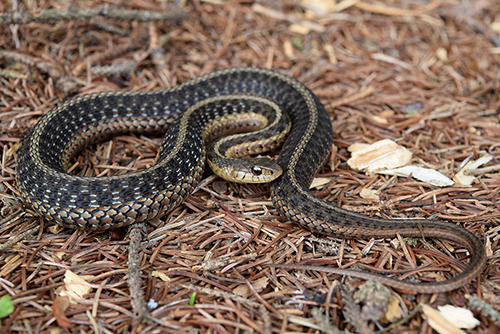
Connecticut’s Department of Energy and Environmental Protection (DEEP) is reminding residents that snakes are active this time of year and if left alone, snakes pose no threat to people. Snake encounters, whether around the home or along a hiking trail, can be alarming for some people. DEEP is offering advice on what to do during snake encounters and a reminder about how important these reptiles are to the natural world.
Snakes and People
Snakes serve dual roles as both predators and prey; their consumption of small mammals helps control rodent and other pest populations, yet they are eaten by many animals, including some mammals and birds of prey.
“Snakes are often needlessly killed by people because of mistaken identity, fear, and misunderstanding,” said Jenny Dickson, DEEP Wildlife Division Director. “If you unexpectedly come across a snake, the snake is likely as startled as you are. The best course of action is to remain calm. All snakes will retreat from humans if given a chance.”
What to Do
Do not kill snakes that you encounter. It is recommended that you observe and enjoy snakes from a distance and allow them to go on their way. It is important to keep in mind that snake species are shy and non-aggressive. The two venomous snake species found in Connecticut (timber rattlesnake and eastern copperhead) are not widely distributed, and most people are unlikely to encounter a venomous snake around their home. These two venomous snakes, along with the other 12 Connecticut snake species, will only bite if threatened or handled. If left alone, snakes pose no threat to people.
Some snake species such as gartersnakes are often encountered in yards and around outbuildings. Occasionally, they will enter homes and outbuildings in search of food. A non-venomous snake found in the home can be easily and safely removed. A pair of garden gloves is sufficient protection from gartersnakes, which prefer to emit an odor (musk) in defense but will occasionally bite when handled. All snakes have teeth; a bite on an unprotected hand is not dangerous but can break the skin and be painful and startling. The snake should be picked up carefully to avoid excessive squeezing. Snakes have delicate bodies and are easily injured. Place the snake in a cloth bag or bucket and release it in an area not far from the point of capture so the snake will be in familiar territory. In the rare event of encountering a venomous snake on your property, it is best to leave it alone and allow it to move along. To discourage snakes from entering buildings, make sure all cracks in the foundation are sealed. Basement windows should close tight or be covered with screens. Most snakes do not require large openings to gain entrance.
If you wish to discourage snakes from your yard, remove the places where they can hide. Cut grass short, remove brush and rock piles, and trim shrubs up off the ground. This will also discourage the prey species snakes feed on making the yard less attractive to snakes. More information about snakes and snake conservation in Connecticut, as well as an identification guide, can be found on the DEEP website at https://portal.ct.gov/DEEP/Wildlife/Learn-About-Wildlife/Snakes-of-Connecticut.
You can also send photos of snakes to deep.ctwildlife@ct.gov to ask for identification assistance.